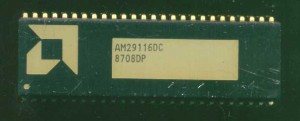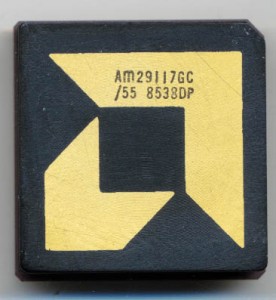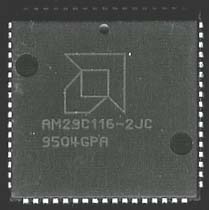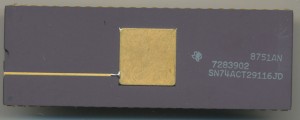AMD Am29116: A Bit Better than a Bit Slice Processor
In 1980 there was not yet a clear winning architecture for microprocessors. Many of the companies of the 1970’s were still churning out designs, hoping for design wins. Intel had yet to become a dominating force, though their 8086 line was becoming popular. AMD was one of the innovators of the time. Now known for their x86 processor, AMD made many other designs that were very successful.
In 1980 AMD was already making 2 16-bit class processors. They were a second source for the Intel 8086 (8/16 bit) as well as the primary second source for the Zilog Z8000 processor. They soon would pick up manufacturing demand for the Intel MCS-51 line as well. This was not enough for AMD, they sought to design a 16-bit microprocessor that would excel at high speed control applications (such as telecom and disk controllers). Thus began one of the most ambitious and complex designs of the time. In order to meet their performance goals the design had to be done in ECL, on a bipolar process, this is a bit more complicated for a large device then a NMOS part, mainly due to its power requirements and heat.
In 1981 AMD announced the Am29116 microprogrammed 16-bit processor. It was made on a 2 micron process and contained 2500 effective gates (~14,000 transistors, 50mm2 die area). Max speed was 10 MHz. Samples were available starting in early 1982. The target competition was not the 8086 or Z8000 but The DEC T-11 ‘Tiny’ processor, which was made in NMOS and ran at 2.5MHz. The Am29116 is technically a bit-slice processor, like AMD’s wildly successful 2901 processor but adds a bit more functionality including instruction for bit manipulation, CRC generation, as well as a barrel shifter and an on chip scratch pad RAM (32x16bit). It has an accumulator, ALU, status register, and instruction latching/decoding for the 167 instructions. What the 29116 lacks is a PC (Program Counter). Program sequencing is handed by external logic, either custom, or using AMD 29112 microprogram sequencers. It is the job of the sequencer to feed instructions to the 291116, handled jumps, calls, returns, and memory accesses. This puts the 29116 somewhere between the basic 2901 and a full featured processor like the Z8000. AMD also produced the 29117 which added a second 16-bit port, resulting in a dedicated input port (D) and a dedicated output port (Y), whereas the 29116 had a single I/O port. This allowed for faster processing where data could be read and written simultaneously. The 29117 was available in a PGA68 package (16 more pins then the DIP52 of the 29116)
AMD moved the 29116 to a 1.5u IMOX bipolar process in 1986 resulting in the 29116A which ran at 12.5MHz and the 29L116A which ran at 10MHz but consumed 25% less power (die area reduced to 33mm2). AMD also was working on a CMOS version of the 29116. It was expected to run slower then the 29116 in Bipolar but by the time it went into production in 1987 its base version was as fast as the 29116. Three versions were made, the 10MHz 29C116, a 11.1MHz 29C116-1 and a 12.5MHz 29C116A. By 1988 the 29C116A had been renamed the 29C116-2. Die area for the CMOS version was roughly 19mm2 on a 1.2-1.6 micron process (documentation is not clear which was used for full production, it appears the die area increased from prelim data to production data)
Documentation suggests that all versions of the 29116 were licensed to Thomson/CSF for the European market but I have not yet found an example of one. Texas Instruments made a copy of the CMOS 29116 called the SN74ACT29116 and 74ACT29116-1 both made on a 1u EPIC CMOS process. In addition Cypress semiconductor also made many CMOS versions known as the CY7C9116 and CY7C9117 with speeds up to 28MHz. These are usually marked with a max prop delay (such as CY7C9116-35 meaning a 35ns part, lower is faster in this case).
Both Cypress and AMD continued to make the ‘116 into the late 1990’s. It continued to be used in control systems, video system, telecom products and many military applications. Its high speed and support for bit oriented instructions, as well as the ability to custom design a sequencer for it allowed it to be used in a wide range of products.






May 3rd, 2015 at 2:54 pm
[…] of the 1970’s (being made well into the 1990’s), as well as the previously detailed AM29116 16-bit processor released in 1981. However, the 1980’s brought another AMD design as well, though not as […]